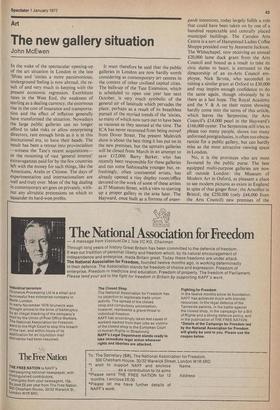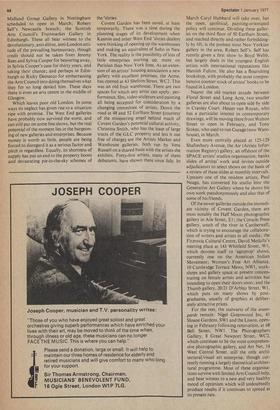The new gallery situation
John McEwen
In the wake of the spectacular opening-up of the art situation in London in the late 'fifties and 'sixties a more parsimonious, underground feeling is now abroad, the result of and very much in keeping with the present economic regression. Exorbitant rates in the West End, the weakness of sterling as a dealing currency, the enormous rise in the cost of insurance and transportation and the effect of inflation generally have transformed the situation. Nowadays the large public galleries can no longer afford to take risks or allow enterprising directors, rare enough birds as it is in this institutional era, to have their heads. The result has been a retreat into provincialism —witness the Tate's recent acquisitions— or the mounting of vast 'general interest' extravaganzas paid for by the few countries left with the money for such things, like the Americans, Arabs or Chinese. The days of experimentation and internationalism are well and truly over. Most of the big dealing in contemporary art goes on privately, without any altruistic pretensions on which to squander its hard-won profits.
It must therefore be said that the public. galleries in London are now hardly worth considering as contemporary art centres in the context of other civilised capital cities. The balls-up of the Tate Extension, which is scheduled to open one year late next October, is very much symbolic of the general air of lassitude which pervades the place, perhaps as a result of its breathless pursuit of the myriad trends of the 'sixties, so many of which now turn out to have been as vacuous as they seemed at the time. The ICA has never recovered from being moved from Dover Street. The present Malevich show is about the best thing it has put on in the new premises, but the upstairs galleries will be closed from March in an attempt to save £12,000. Barry Barker, who has recently been responsible for these galleries and ran some fashionable younger but, refreshingly, often continental artists, has already opened a tiny display room/office devoted to the work of some of these artists at 37 Museum Street, with a view to starting up a proper gallery in the area later. The Hayward, once built as a fortress of avant garde intentions, today largely fulfils a role that could have been taken on by one of a hundred respectable and centrally placed municipal buildings. The Camden Arts Centre is a sort of Hampstead Ladies Coffee Shoppe presided over by Jeannette Jackson. The Whitechapel, now receiving an annual £20,000 lame duck grant from the Arts Council and bound as a result to take its civic duties to heart, is entrusted to the directorship of an ex-Arts Council employee, Nick Se7ota, who succeeded in raising a similar grant at Oxford to £30,000 and may inspire enough confidence to do the same again, though obviously he is there as a last hope. The Royal Academy and the V & A on their recent showing hardly come into the terms of this article, which leaves the Serpentine, the Arts Council's £14,000 pearl in the Hayward's £166,000 oyster. The Serpentine still tries to please too many people, shows too many unformed postgraduates, is often too obscurantist for a public gallery, but can hardly miss as the most attractive viewing space in London.
No, it is the provinces who are most favoured by the public purse. The best equipped multi-purpose galleries are now all outside London: the Museum of Modern Art in Oxford, as pleasant a place to see modern pictures as exists in England in spite of that ginger floor; the Arnolfini in Bristol; the £250,000 (only £44,000 from the Arts Council) new premises of the
Midland Group Gallery in Nottingham scheduled to open in March; Robert Self's Newcastle branch; the Scottish Arts Council's Fruitmarket Gallery in Edinburgh. These all bear, witness to the devolutionary, anti-elitist, anti-London attitude of the prevailing bureaucracy, though credit should not be taken from Jeremy Rees and Sylvia Cooper for beavering away, in Sylvia Cooper's case for thirty years, and taking their chance; and perhaps in Edinburgh to Ricky Demarco for embarrassing the Arts Council into doing themselves what they for so long denied him. These days there is even an arts centre in the middle of Glasgow.
Which leaves poor old London. In some ways its neglect has given rise to a situation ripe with promise. The West End galleries have probably now survived the worst, and can still put on some fine shows, but the real potential of the moment lies in the burgeoning of new galleries and enterprises. Because money is worth so little, people are being forced to disregard it as a serious factor and pitch in regardless. Equally, its shortness of supply has put an end to the property boom and devastating pie-in-the-sky schemes of
the 'sixties.
Covent Garden has been saved, at least temporarily. There was a time during the planning stages of its development when Kasmin and other West End 'sixties dealers were thinking of opening up the warehouses and making an equivalent of Soho in New York. The reality is the possibility of lots of little enterprises starting up, more on Parisian than New York lines. As an extension of an artists' housing association a new gallery with excellent premises, the Acme, has opened at 43 Shelton Street, WC2. This was an old fruit warehouse. There are two spaces for which any artist can apply : performance, film, video sculpture and painting all being accepted for consideration by a changing committee of artists. Down the road at 48 and 52 Earlham Street (courtesy of the ministering angel behind much of Covent Garden's potential cultural activity, Christina Smith, who has the lease of large tracts of the G LC property and lets it out free of charge) are the Artists Market and Warehouse galleries, both run by Vera Russell on a shared basis with the artists she exhibits. Forty-five artists, many of them debutants, have shown there since July. In
March Caryl Hubbard will take over, but the open, apolitical, painting-orientated policy will continue. Dividing these galleries on the third floor of 50 Earlham Street, and reached directly and rather forbiddingly by lift, is the poshest most New Yorkian gallery in the area, Robert Self's. Self has rcently given a first show to Boyd Webb, but largely deals in the youngest English artists with international reputations like Hamish Fulton. He also has a flourishing bookshop, with probably the most comprehensive counter stock of artists' books to be found in London.
Nearer the old market arcade between Floral Street and Long Acre, two smaller galleries are also about to open side by side in Cranley Court. Hester van Royan, who has a particular interest in contemporary drawings, will be moving there from Walton Street to open in February, and Tony Stokes, who used to run Garage (now Warehouse), in March.
Even more centrally placed at 125-129 Shaftesbury Avenue, the Air (Artists Information Registry) gallery, an offshoot of the SPACE artists' studios organisation, banks slides of artists' work and invites outside adjudicators to select shows on the basis of a review of these slides at monthly intervals. Upstairs one of the resident artists, Paul Neagu, has converted his studio into the Generative Art Gallery where he shows his own work pseudonymously and also that of some of his friends.
Of the newer galleries outside the immediate vicinity of Covent Garden, there are most notably the Half Moon photographic gallery in Alie Street, El; the Coracle Press gallery, south of the river in Camberwell, which is trying to encourage the collaboration of writers and artists in all media; the Fitzrovia Cultural Centre, David Medalla's meeting place at 143 Whitfield Street, WI, which devotes itself to 'agitprop' shows, currently one on the American Indian Movement ; Women's Free Art Alliance, 10 Cambridge Terrace Mews, NW1, workshops and gallery space at present concentrating on female artists and activities but intending to open their doors soon; and the Thumb gallery, 20/21 D'Arblay Street, WI, which puts on many shows by postgraduates, usually of graphics at deliberately attractive prices.
For the rest, the stalwarts of the avantgarde remain: Nigel Greenwood Inc, 41 Sloane Gardens, SWI and the Lisson, opening in February following renovation, at 68 Bell Street, NW1. The Photographers Gallery, 8 Great Newport Street, WC2, which continues to be the most comprehensive photographic gallery, and Art Net, 14 West Central Street, still the only architectural/visual art enterprise, though currently running a largely theoretical architectural programme. Most of these organisations survive with limited Arts Council help, and bear witness to a new and very healthy mood of optimism which will undoubtedly produce results if it continues to spread at its present rate.























































 Previous page
Previous page